¿Quiénes son los terroristas suicidas?
Curioso comentario. El autor ha estado compilando una base de datos de todos los ataques suicidas del mundo desde 1980 hasta 2001: un total de 188. El resultado: hay poca relación entre ataques terroristas suicidas y la religión. De hecho, el grupo con más ataques son los Tígres de Tamil, que son aparentemente ateos:
I have spent a year compiling a database of every suicide bombing and attack around the globe from 1980 to 2001 – 188 in all. It includes any attack in which at least one terrorist killed himself or herself while attempting to kill others, although I excluded attacks authorized by a national government, such as those by North Korea against the South. The data show that there is little connection between suicide terrorism and Islamic fundamentalism, or any religion for that matter. In fact, the leading instigator of suicide attacks is the Tamil Tigers in Sri Lanka, a Marxist-Leninist group whose members are from Hindu families but who are adamantly opposed to religion (they have have committed 75 of the 188 incidents).
Rather, what nearly all suicide terrorist campaigns have in common is a specific secular and strategic goal: to compel liberal democracies to withdraw military forces from territory that the terrorists consider to be their homeland. Religion is rarely the root cause, although it is often used as a tool by terrorist organizations in recruiting and in other efforts in service of the broader strategic objective.
Y luego realiza su análisis:
How should democracies respond? In the past, they have tended to react with heavy military offensives, only to find that this tends to incite more attacks and to stir public sympathy for the terrorists without hampering their networks (this has clearly been the case in the West Bank and Chechnya). In their frustration, some terrorized countries have then changed tacks, making concessions to political causes supported by terrorists.
Yet this doesn’t work either: one likely reason suicide terrorism has been rising so rapidly in recent years is that terrorist groups have learned that the strategy pays off. Suicide terrorists were thought to compel American and French military forces to abandon Lebanon in 1983, Israeli forces to leave most of Lebanon in 1985, Israeli forces to quit the Gaza Strip and the West Bank in 1994 and 1995, and the Turkish government to grant measures of autonomy to the Kurds in the late 1990’s. In all but the case of Turkey, the terrorists’ political cause made far greater political gains after they resorted to suicide operations.
When one considers the strategic logic of suicide terrorism, it becomes clear that America’s war on terrorism is heading in the wrong direction. The close association between foreign military occupations and the growth of suicide terrorist movements shows the folly of any strategy centering on conquering countries that sponsor terrorism or in trying to transform their political systems. At most, occupying countries will disrupt terrorist operations in the short term. But over time it will simply increase the number of terrorists coming at us.
[Estoy escuchando: «I’m Glad There Is You» de Chet Baker en el disco My Funny Valentine [Blue Note]]
